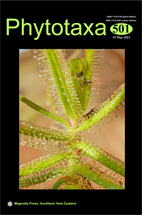Abstract
Thymus ×porcii is a natural hybrid between T. pannonicus and T. pulegioides, occurring within the co-occurrence range of its parental species in the forest and forest-steppe zones of Europe. Taxonomy and nomenclature of this hybrid present a longstanding puzzle due to the lack of critical evaluations of the original material as well as conflicting taxonomic interpretations of the parent taxa both at specific and intraspecific levels. The present paper attempts to clarify these issues, arguing against the synonymic treatment and/or consolidation of T. pannonicus and T. pulegioides, which is accepted in modern taxonomies apparently as a result of nomenclatural confusion related to T. pannonicus typification. Based on morphology and reported molecular data, it is proposed to treat T. pannonicus and T. pulegioides as separate species, each containing two varieties being well-distinguished by the presence or absence of leaf indumentum: T. pannonicus var. latifolius (glabrous leaves) and T. pannonicus var. pannonicus (pubescent leaves), and T. pulegioides var. pulegioides (glabrous leaves) and T. pulegioides var. vestitus (pubescent leaves). In view of such treatment, T. ×porcii is divided into three nothovarieties, representing natural crosses between different varieties of the parent species. Namely, in addition to the typical T. ×porcii nothovar. porcii [T. pannonicus var. latifolius × T. pulegioides var. pulegioides] (with T. ×pilisiensis and T. ×goginae as the taxonomic synonyms), we describe a new nothovariety T. ×porcii nothovar. calvariensis [T. pannonicus var. pannonicus × T. pulegioides var. pulegioides], and propose a new nomenclatural combination T. ×porcii nothovar. opizii [T. pannonicus × T. pulegioides var. vestitus] based on the previously published name T. ×opizii. On the basis of original material examination, two collections from BP are designated here as the lectotypes of T. ×porcii (≡ T. ×porcii nothovar. porcii) and T. ×pilisiensis respectively, and one specimen from PR is designated as the lectotype of T. ×opizii (≡ T. ×porcii nothovar. opizii). Main diagnostic traits of T. ×porcii nothovarieties and their parental taxa are compared and discussed.

